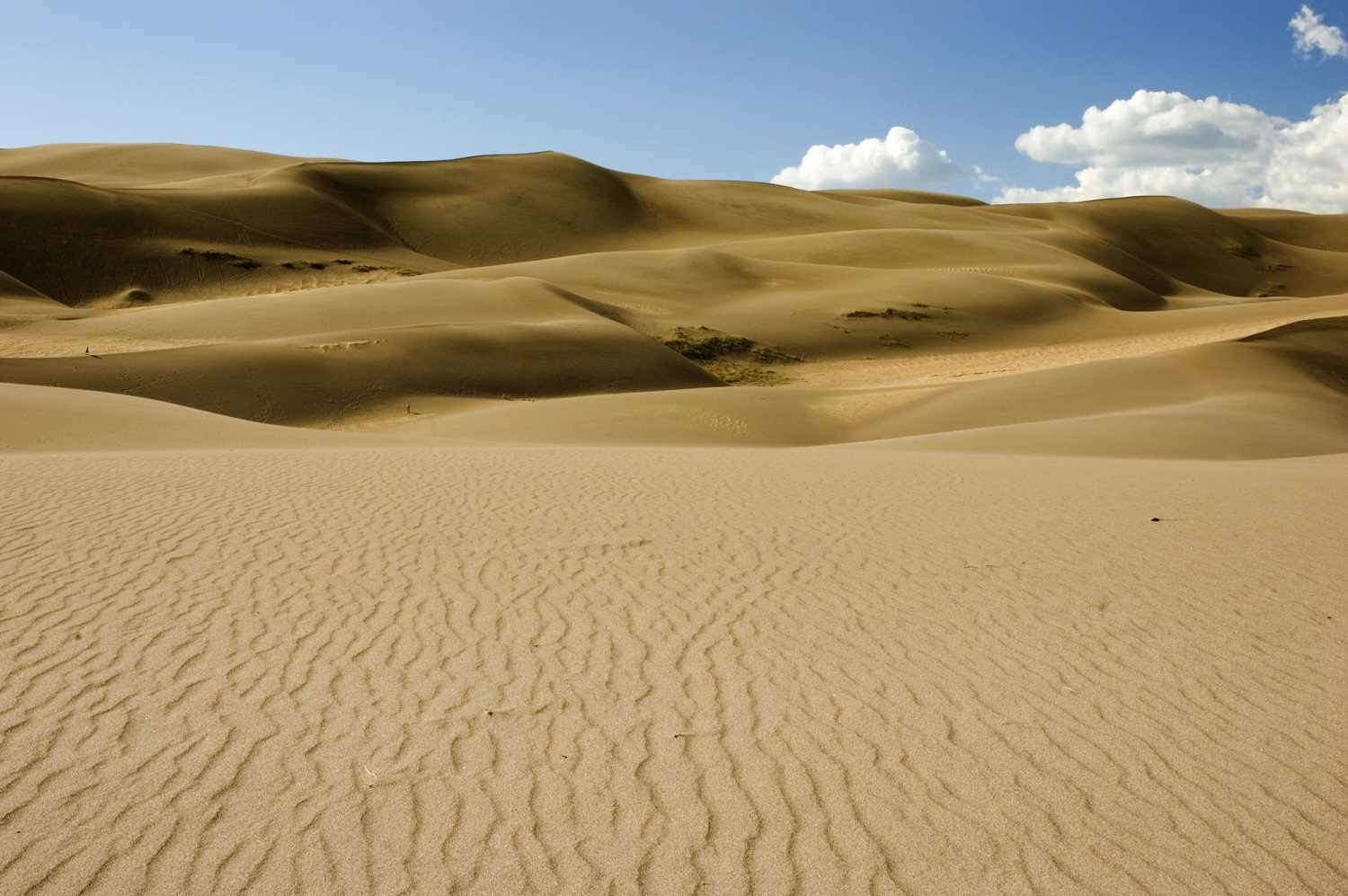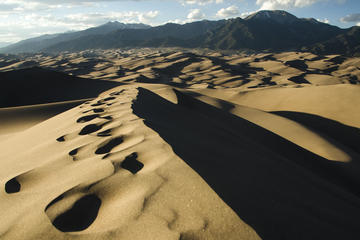Colorado”]
A sea of sand in Colorado far from any ocean.
Great Sand Dunes National Park
Play in the sand.
The tallest sand dunes in North America are in Great Sand Dunes National Park in Colorado. There are mile after mile of sand dunes extending up to 750 feet tall. The sand stretches across San Luis Valley, between the San Juan Mountains and the Sangre de Cristos. In total, there are more than 30 square miles of sand dunes being constantly reshaped by the winds reaching 40 miles an hour.
The park is located three hours southeast of Colorado Springs. It was originally declared a national monument in 1932 but Congress elevated it to national park and preserve status in 2004. the national park covers about 44,000 acres and the preserve protects another 41,500 acres (approximately). The sand dunes were formed from sand and soil deposits from the Rio Grande. The park also protects the water that lies a few inches under the sand.
Open / Close / Reopening Status of Great Sand Dunes National Park due to Coronavirus (COVID-19)
More information about Great Sand Dunes
Last Updated: May 2, 2020
Distance from Nearby Major Cities:
Denver, CO: 240 miles (3.75 hours)
Albuquerque, NM: 237 miles (4 hours)
Grand Junction, CO: 257 (4.75 hours)
Busiest Months
Sand Dunes
Sandboarding and sand sledding are the park’s most popular activities. But you’ll probably need to avoid the heat of the day when the sand heats up. Grab a sand board or sand sled that is specially designed for sand. They are available for rent at two local retailers (but not from the national park). Snow sleds, skis, snowboards, cardboard saucers and soft plastic don’t work on the sand. You’ll also need to watch out for windy spring afternoons and thunderstorms.
Medano Creek
A seasonal stream that largely exists from late April through June with peak water flow in late May or early June. Weekends in late May and early June are popular here with large crowds. Wading, skimboarding, sand sculpting and sand castles are typical activities.
Medano Pass Primitive Road
A 22 mile scenic backcountry road requiring a high clearance four wheel drive vehicle to keep moving through the sand and creek crossings in the summer. Trail damage is a real possibility. Average speed on the road is 5-10 miles per hour. At the start of the route is the Pinyon Flats Campground and there are 21 campsites along the primitive road. Fat Bikes with their extra wide mountain bike tires are also allowed on the road. Four wheel drive tours and Jeep rentals are also available via Pathfinders 4×4.
Fishing Great Sand Dunes
Trout Unlimited did a blog post in 2016 about the “phenomenal” fishing opportunities in Great Sand Dunes. It recommended fishing for the catch-and-release only Rio Grande cutthroat trout in Medano Creek and Medano Lake. Another option is Lower Sand Creek Lake or Upper Sand Creek Lake, which is about a 3.5 mile hike from the Music Pass trailhead. Both lakes offers cutthroat genetics.
Recent Bird Sightings
Hiking Trails:
Weather Forecast:
[wunderground location=”Alamosa, CO” numdays=”4″ layout=”simple” showdata=”search,alert,daynames,highlow,pop,icon,text,conditions,date”]
Average Temperature (Monthly)
Camping and Lodging:
Pinon Flats Campground is located one mile north of the visitor center and is open from April through October. There are three loops with a total of 88 campsites and three group sites. Additional camping is available for those traveling on Medano Pass Primitive Road.
The closest hotels to the park are in Alamosa, a thirty minute drive. The population of Alamosa is approximately 8,700.
Campground Reservations:
Lodging:
Vacation Packages:
Roundtrip Flights to Colorado Springs
[tp_in_our_city_fly_shortcodes destination=COS title=”” limit=15 paginate=false stops=0 one_way=false off_title=true subid=”” currency=”USD”]
Shop:
Frequently Asked Questions
What is there to do in the Great Sand Dunes?
Climb the sand dunes, enjoy sandboarding and sand sledding, go horseback riding, or off-road in a 4×4 or fat bike on Medano Pass, enjoy the stars in this International Dark Sky Park, and play in Medano Creek
What is the best time to visit Great Sand Dunes National Park?
The vast majority of people visit the national park between May and September, with more than half of all visitors choosing to time their visit in June, July and August.
Can you drive on the Great Sand Dunes?
You can not take a motorized vehicle on the dunes in the park. Motorbikes are also prohibited on the dunes, and ATVs are not permitted in the park and preserve. Medano Pass Road in the park is a primited road for 4WD high clearance, street licensed vehicles which is soft and sandy in the dunes area.
What city is the Great Sand Dunes National Park?
The closest city to Great Sand Dunes is Alamosa, which is the county seat of Alamosa County. It is the gateway city to the park, with hundreds of hotel rooms and more than 35 restaurants. It is a little over thirty minutes from the park. The closest major city in the area is Pueblo. The population of the Pueblo-Canon City area is over 200,000. Pueblo is two hours away.
How long does it take to climb the Great Sand Dunes?
It takes about an hour to climb from the visitor center parking lot to the top of High Dune. High Dune rises 699 feet from its base.
American Samoa
Arches
Badlands
Big Bend
Biscayne
Black Canyon
Bryce Canyon
Canyonlands
Capitol Reef
Carlsbad Caverns
Channel Islands
Congaree
Crater Lake
Cuyahoga Valley
Death Valley
Denali
Dry Tortugas
Everglades
Gates of the Arctic
Glacier Bay
Glacier
Grand Canyon
Grand Teton
Great Basin
Great Sand Dunes
Great Smoky Mountains
Guadalupe Mountains
Haleakala
Hot Springs
Hawaii Volcanoes
Hot Springs
Isle Royale
Joshua Tree
Katmai
Kenai Fjords
Kings Canyon
Kobuk Valley
Lake Clark
Lassen Volcanic
Mammoth Cave
Mesa Verde
Mount Rainier
North Cascades
Olympic
Petrified Forest
Pinnacles
Redwood
Rocky Mountain
Saguaro
Sequoia
Shenandoah
Theodore Roosevelt
Virgin Islands
Voyaguers
Wind Cave
Wrangell-St. Elias
Yellowstone
Yosemite
Zion



